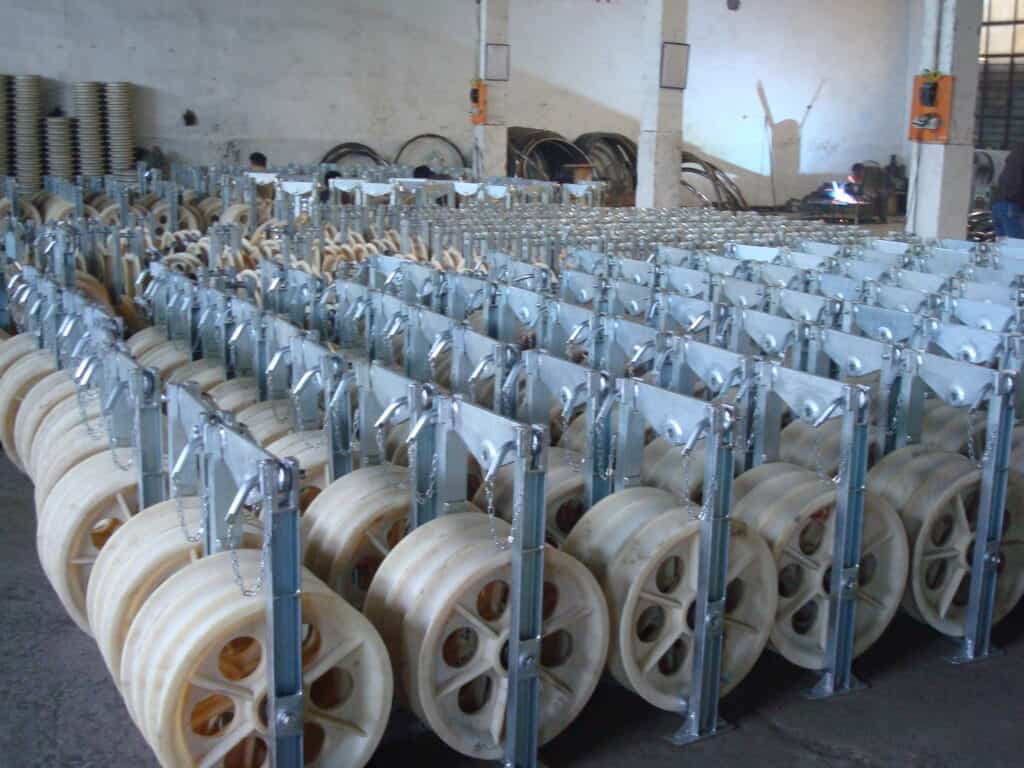Contact Us Now: +86-13813186357 | frank@qy-stringingtools.com

Definition and Characteristics of conductor stringing blocks.
There are two kinds of aluminum wheels and MC nylon conductor stringing blocks according to material, and the styles are divided into tube type and plate type. Application of large diameter stringing pulley: it is used for paying off single conductor, double split conductor, and four split conductors (the intermediate wheel can be cast steel wheel or nylon wheel). Characteristics: it is suitable for tension paying off.
Ground wire stringing blocks: it is suitable for extending lightning wires or crossing steel strands, including steel and MC nylon. Special pulley for optical cable:
1) For laying OPGW composite ground wire optical cable or ADSS self-supporting optical cable, a small groove is provided at the bottom of the wheel groove, which is specially manufactured for protecting optical cable;
(2) The wheel is made of MC nylon by die casting, which will not damage the outer skin of the optical cable during paying off; Model: CH-15; Rated load (KN): 40; Outer diameter of wheel (mm): 660; Wheel bottom diameter (mm): 546; Wheel width (mm): 90; Applicable optical cable (mm): Φ 5- Φ 14.05; Dead weight (kg): 30; Model: ch-18; Rated load (KN): 50; Outer diameter of wheel (mm): 830; Wheel bottom diameter (mm): 698; Wheel width (mm): 110; Applicable optical cable (mm): Φ 15.08- Φ 22; Dead weight (kg): 37;
Stringing method
It is for the convenience of workers and the construction in strict accordance with the design drawings. Generally speaking, all building axes can be called large lines, and the corresponding small lines are the sidelines and dimension lines of structural members. The main idea of stringing is to copy the size of the design drawing to the ground according to the size shown in the drawing. Whether the size of the whole project is constructed according to the size of the design drawing depends on the setting out.
There are various setting out methods for a construction setting out site operation; Generally, there are gantry plate positioning ruler and instrument measurement and setting out. The former is based on the known control points in the drawing or the control points determined on the site, piling and erecting gantry plate at a certain distance around the foundation of the building to be set out. Draw a roughly straight line on the gantry plate with the construction line, and try to tighten the line. Then use the Pythagorean theorem to use a steel ruler. The size should be larger, generally, 6, 8, or 10m, which is more accurate, First, measure the size on the two control lines and set out the points with a red pencil. Then two people pull a ruler. One person swings the ruler to stabilize the size of any line and the steel ruler. Then, fix the construction line on the gantry plate and calibrate it again with a steel ruler. After confirmation, hang lines around and check with a steel ruler. Measure the setting out points with a steel ruler according to the axis size on the drawing and hang it on the ground with a plumb line. In this way, the lines can be excavated with lime powder, Measure and set out the control elevation on the gantry plate with a level gauge.
If the latter can use theodolite or total station, it will be much simpler. As long as the distance and angle relationship on the drawing can be measured and determined according to the known control points on the drawing or the control points determined on-site [1].
Site Stringing
The on-site setting out is to facilitate the workers’ work, and also to carry out the construction in strict accordance with the design drawings. Generally speaking, all building axes can be called large lines, and the corresponding small lines are the sidelines and dimension lines of structural members. The main idea of setting out is to copy the size of the design drawing to the ground according to the size shown in the drawing. Whether the size of the whole project is constructed according to the size of the design drawing depends on the setting out. In addition, the setting out is to provide a dimensional basis for all construction. The reinforcement workers shall bind the reinforcement based on the line and find the correct position. The carpenter shall also support the formwork based on the line. The bricklayer shall also build the wall based on the line. It is not allowed to bind, support, and build without dimensional constraints.
Setting out is very important for high-rise buildings. If the axis of each floor is not on a vertical plane, it will not necessarily be a traditional four-square building.
Construction Stringing
1. Building positioning
It is the first setting out after the commencement of the housing construction project. The personnel participating in the building positioning are the urban planning department (subordinate survey team) and the surveying personnel (Professional) of the construction unit. The positioning is carried out according to the building planning positioning map, and finally (at least) 4 positioning piles are formed at the construction site. The setting out tool is “total station” or “advanced theodolite”.
2. Foundation construction Stringing
After the setting of the building positioning piles, the professional surveyor of the construction unit, the person in charge of the construction site, and the supervisor shall jointly set out and recheck the foundation works (the supervisor is mainly responsible for on-site supervision and verification), and finally set out the positioning piles of all building axes (the axis can also be set out at intervals according to the size of the building), All axis positioning piles are set out according to the positioning piles (at least 4) of the planning department and the construction plan of the bottom floor of the building. The setting out tool is “theodolite”.
After the foundation positioning and setting out are completed, the surveyors and constructors at the construction site shall set out the sideline of the foundation according to the positioning axis for foundation excavation. Setting out tools: theodolite, gantry plate, wire rope, wire pendant, steel tape, etc. There may be no Surveyors for small projects, that is, the constructors set out.
Note: the foundation axis positioning pile must be led to the permanent buildings or fixed objects around the proposed building at the same time as the foundation set out to prevent the axis positioning pile from being damaged for remediation.
3. Main construction Stringing
After the construction of foundation works is positive or negative, the first floor and the second floor of the main body are immediately followed Until the construction and setting out of the capping of the main body, setting out tools: theodolite, wire pendant, wire rope, ink bucket, steel tape, etc. The construction setting out shall be carried out according to the axis positioning pile and the external axis datum line. Use a theodolite to drive the axis onto the building, snap the axis on the construction level of the building, and then set out the column, wall, and other sidelines according to the axis. Do this for each floor until the main body is capped [1].
